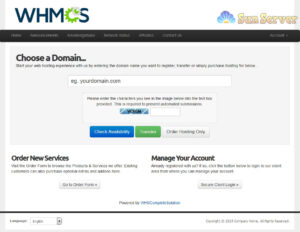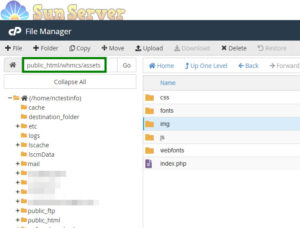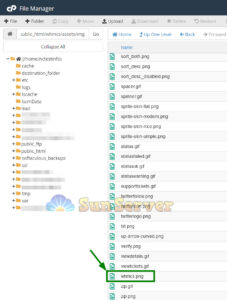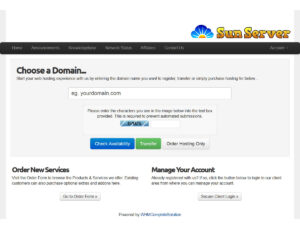With Onepager, you can build a professional-looking website all by yourself without any coding knowledge. Onepager websites are search engine-friendly and are designed to look great on mobile devices. You can also monitor your business’s online reputation and connect with your customers using the Onepager interface.
What are DNS Template Setup?
We are thrilled to introduce our latest feature, the DNS Templates, aimed at streamlining the DNS setup process. You can find this feature in your Sun Server account under the Advanced DNS tab. It can be utilized if your domain name is currently pointing to our BasicDNS or PremiumDNS services. At the moment, you can only link your domain to a Shopify, Weebly, or Wix account.
Please note that, in the case of Wix, your website must be upgraded to a Premium Plan before you can connect your domain. You can find more information on this in the provided article.
For a smooth setup of a Shopify DNS Template, Weebly DNS Template, or Wix DNS Template, it’s important to remove or replace certain conflicting records with the necessary ones, such as new A records. We highly recommend saving your current settings so that you can easily revert to them if necessary.
Additionally, please be aware that when the Host Records section already contains various settings, our system will attempt to identify potential conflicts between the records and apply the desired settings while preserving the original meaning.
TCP/IP
TCP/IP, short for Transmission Control Protocol/Internet Protocol, currently in its fourth revision known as IPv4, and sometimes referred to as 4bone, serves as a communication framework used to transmit data across networks. It stands as the primary protocol governing the operation of the Internet.
TCP/IP comprises a collection of directives that outline the process of sending data packets across various networks. The TCP segment manages the confirmation of packet delivery, while the IP segment is responsible for the routing of data packets between nodes.
IP Address
An IP address, which stands for Internet Protocol Address, is a numeric code that typically serves as a unique identifier for a specific computer on the Internet. It is formatted as a 32-bit numeric address, represented as four 8-bit octets of numbers, each separated by dots. Each octet contains a number ranging from 0 to 255. The first group falls between 1 and 255, while the subsequent groups can vary from 0 to 255. These IP addresses are organized into subnetworks, known as subnets, which consist of 4-number IP addresses. Subnets can belong to different classes, each of which specifies how many IP addresses are within one subnet.
The classes of subnets include:
1. Class C: In this class, the first three octets are identical. For example, the following IP addresses belong to the same Class C subnet: 4.4.3.5 and 4.4.3.118.
2. Class B: In Class B, the first two octets are the same. For instance, 4.4.3.5 and 4.4.7.45 belong to the same Class B subnet.
3. Class A: Class A subnets share the same first octet. For example, 4.2.4.6 and 4.87.97.110 belong to the same Class A subnet.
Additionally, there are classless subnets that are utilized to separate subnets that don’t conform to the A, B, and C classes. Various subnets are designated for private use and are not routed on the internet. These are referred to as private networks and include IP ranges such as 192.168.0.0/16, 172.16.0.0/15, and 10.0.0.0/8. These private networks are suitable for local area networks (LANs), while other IP ranges are intended for public use on the Internet or wider area networks (WANs).
IP addresses can be categorized as static (permanently assigned and associated with a specific device) or dynamic (temporary addresses that change each time you connect to your Internet Service Provider, often used in dial-up or DSL networks). The currently prevalent IP standard is known as IPv4, based on the number of octets. However, a newer standard, IPv6, is being implemented and is intended to replace IPv4. Several regional Internet registries, including ARIN, RIPE NCC, LACNIC, and APNIC, are responsible for assigning Internet addresses across these classes.
What is PTR Record?
A PTR (pointer) record maps an IP address to the domain name. It’s often called a “reverse DNS entry” because it converts an IP address to a name.
PTR records are mostly used as a security and anti-spam measure, to verify that a mail server address is allowed to send an email to a particular hostname. The reverse DNS entry checks if a server name is indeed associated with an IP address from where the connection was initiated.
In order to set up a reverse DNS entry that will connect an IP address to your domain (e.g., 127.0.0.1 should be mapped to yourdomain.com), you will need to contact your IP address provider to create a PTR record for the IP address.
Are there any alternate Dynamic DNS clients?
Yes, there are many clients available on the internet. Some clients that may support Namecheap Dynamic DNS are provided below.
Please note that the clients supporting Namecheap DNS may or may not be available immediately. Please contact the respective provider for more information or request adding Namecheap support to their clients.
Windows: Direct Update
Mac: NC DNS Updater, IP Monitor
Unix: DDClient , IPCheck
Other: Java Dynamic DNS Client, IPCheck for OS/2
Where Is Your Company Located?
Our Company Is Located At :
Sun Infosoft India, 537/108, Sun Tower, Baldeobagh, Jabalpur, Madhya Pradesh 482002
Mr. Ram Murty Sharma
(CEO)
How to brand WHMCS?
Establishing a strong online presence through branding is crucial for any business. The more frequently your company’s brand is visible, the more it becomes ingrained in the minds of your customers.
In this article, we will guide you on how to replace the default WHMCS logo with your own logo.
WHMCS, short for WHM Complete Solution, is a highly popular comprehensive client management, billing, and support system tailored for hosting reseller businesses. The WHMCS client area is designed to be customizable, allowing you to modify the visual appearance of your entire interface. WHMCS utilizes the powerful Smarty template system, making it easy to personalize the layout.
By default, the WHMCS Client Area has this appearance:

Of course, you’d prefer your customers to see your company logo in this space. The process of changing the logo is straightforward and involves a few simple steps:
1. Access your cPanel and navigate to the directory where WHMCS is installed.
2. Open the “assets” folder.

3. Inside the “assets” folder, locate the “img” folder and find the “whmcs.png” file within it.

4. Now, you need to upload your custom logo file to this directory and rename it as “whmcs.png.” You can also rename the original file to something like “whmcs_old.png.”
5. Be sure to adjust the image size *before* uploading it to ensure the best logo scaling. You might opt for a logo with a transparent background for seamless integration with the header background.
6. Refresh the WHMCS client portal to view your new logo:

End of Blog
Acceptance criteria for new affiliates
Affiliate Membership is at the sole discretion of Sun Server. The factors that we consider are as follows:
Affiliates must have:
1. An active website. To be considered “Active”, the website must have an established presence on the web as determined by organic search ranking, traffic to website, and/or industry reputation.
2. Aligned content. The website content must be aligned with our marketplace and target customers (i.e., domain, security, hosting, etc.).
3. Domain registration. The website must be directly registered via your own domain name and not via a 3rd-party vendor (i.e., Squarespace or WordPress).
4. Marketing alignment. Marketing strategy and tactics that are aligned and complementary to Sunserver’s marketing efforts (i.e., social media, web content, advertising, email, loyalty programs, etc.)
5. Legal Compliance. Compliance with all US laws, all laws relevant to your home country, and the rules of our Affiliate Program Terms.
Affiliate Membership criteria is an ongoing obligation and membership may be reviewed and/or revoked at any time.
What is Sandbox?
NOTE: You should whitelist at least one IP before your API access begin to work. Please keep in mind that only IPv4 addresses can be used.
That’s it!



